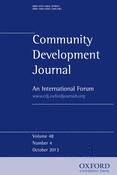-
Views
-
Cite
Cite
Frik de Beer, Community-based natural resource management: living with Alice in Wonderland?, Community Development Journal, Volume 48, Issue 4, October 2013, Pages 555–570, https://doi.org/10.1093/cdj/bss058
Close - Share Icon Share
Abstract
In this paper, the usefulness of the concept of community-based natural resource management (CBNRM) is considered and the following questions are asked: Is ‘community’ in community-based natural resource management a useful concept or a romantic idea? Can natural resources be used as a foundation for asset-based community development? What is the meaning of management in CBNRM? These questions are discussed with reference to a case study on land restitution and CBNRM in the Blyde Nature Reserve in Mpumalanga Province, South Africa. In conclusion, it is argued that a different way of conceptualizing community – the reality of local dynamics – is acknowledged. It is also argued that exploitation of natural resources by communities, however conservation-orientated it may be, is no panacea for rural development and the eradication of poverty. Finally, it is suggested that the management role of the community can be little more than a token role until real ownership and decision-making powers are devolved to the holders of the title deed. As a background, a brief overview of the emergence of CBNRM since the seventies – from deliberations by inter alia the World Council of Churches, the Brundtland report, Agenda 21 (1992), the 2002 Johannesburg Summit, the World Parks Congress in 2003 and the World Conservation Congress of 2004 and 2008 – is provided.



